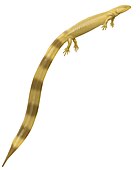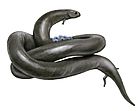
Saichania is a genus of herbivorous ankylosaurid dinosaur from the Late Cretaceous period of Mongolia and China.

Microsauria is an extinct, possibly polyphyletic order of tetrapods from the late Carboniferous and early Permian periods. It is the most diverse and species-rich group of lepospondyls. Recently, Microsauria has been considered paraphyletic, as several other non-microsaur lepospondyl groups such as Lysorophia seem to be nested in it. Microsauria is now commonly used as a collective term for the grade of lepospondyls that were originally classified as members of Microsauria.

Eocaecilia is an extinct genus of gymnophionan amphibian from the early Jurassic Kayenta Formation of Arizona, United States. One species is described, Eocaecilia micropodia.
Goronyosaurus is an extinct genus of marine lizard belonging to the mosasaur family. Fossils of Goronyosaurus are exclusively known from the Dukamaje Formation of Niger and Nigeria and are Maastrichtian in age. The holotype was first described in 1930 as Mosasaurus nigeriensis, but subsequent remains revealed a highly unique set of adaptations that prompted the species to be reclassified as the only species of the new genus Goronyosaurus in 1972. These unique adaptations have made Goronyosaurus notoriously difficult to classify within the Mosasauridae and it is often left out of phylogenetic analyses.

Moschorhinus is an extinct genus of therocephalian in the family Akidnognathidae, with only one species: M. kitchingi. It was a carnivorous, lion-sized synapsid which has been found in the Late Permian to Early Triassic of the South African Karoo Supergroup. It had a broad, blunt snout which bore long, straight canines. It appears to have replaced the gorgonopsids ecologically, and hunted much like a big cat. While most abundant in the Late Permian, it survived a little after the Permian Extinction, though these Triassic individuals had stunted growth.

Labidosaurikos is a genus of extinct captorhinid anapsid reptile that lived around 279 to 272 million years ago during Kungurian age of the lower Permian. The American Paleontologist John Willis Stovall first described Labidosaurikos in 1950, naming it "Labidosaurus like" for the striking similarity of the holotype skull of his specimen to the cranial anatomy of another captorhinid Labidosaurus hamatus. Labidosaurus or generally called “lipped lizard” is another genus of the family Captorhinidae whose name is derived from the Greek “forceps lizard” based on τσιμπίδα and σαυρος ("lizard")
Carrolla is an extinct genus of brachystelechid 'microsaur' that lived in the Lower Permian in North America. It was named in 1986 by American paleontologists Wann Langston and Everett Olson. The type species, Carrolla craddocki, is the only known species.
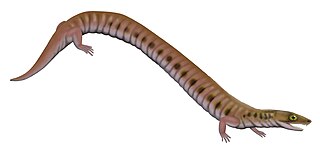
Rhynchonkos is an extinct genus of microsaur. It is the only known member of the family Rhynchonkidae. Originally known as Goniorhynchus, it was renamed in 1981 because the name had already been given to another genus; the family, likewise, was originally named Goniorhynchidae but renamed in 1988. The type and only known species is R. stovalli, found from the Early Permian Fairmont Shale in Cleveland County, Oklahoma. Rhynchonkos shares many similarities with Eocaecilia, an early caecilian from the Early Jurassic of Arizona. Similarities between Rhynchonkos and Eocaecilia have been taken as evidence that caecilians are descendants of microsaurs. However, such a relationship is no longer widely accepted.
Quasicaecilia is an extinct genus of microsaur. It is known from the Early Permian of Texas in the United States. A single specimen is known, collected from the Texas Permian redbeds by Charles Hazelius Sternberg in 1917. It was originally identified as a specimen of the gymnarthrid microsaur Cardiocephalus. The skull is small, less than 2 centimetres (0.79 in) in length, and the otic capsule is very large in comparison to the rest of the skull. The skull of Quasicaecilia superficially resembles those of extant but unrelated caecilians, hence the genus name. Quasicaecilia was assigned to the new family Brachystelechidae in 1991 along with the genera Batropetes and Carrolla.
Pariotichus is an extinct genus of gymnarthrid microsaurs from the early Permian of Texas.
Stegotretus is an extinct genus of lepospondyl microsaur referred to the Pantylidae. It is known from the Carboniferous–Permian boundary Cutler Formation exposures of New Mexico.

Aerosaurus is an extinct genus within Varanopidae, a family of non-mammalian synapsids. It lived between 252-299 million years ago during the Early Permian in North America. The name comes from Latin aes (aeris) “copper” and Greek sauros “lizard,” for El Cobre Canyon in northern New Mexico, where the type fossil was found and the site of former copper mines. Aerosaurus was a small to medium-bodied carnivorous synapsid characterized by its recurved teeth, triangular lateral temporal fenestra, and extended teeth row. Two species are recognized: A. greenleeorum (1937) and A. wellesi (1981).

Biseridens is an extinct genus of anomodont therapsid, and one of the most basal anomodont genera known. Originally known from a partial skull misidentified as an 'eotitanosuchian' in 1997, another well-preserved skull was found in the Xidagou Formation, an outcropping in the Qilian Mountains of Gansu, China, in 2009 that clarified its relationships to anomodonts, such as the dicynodonts.
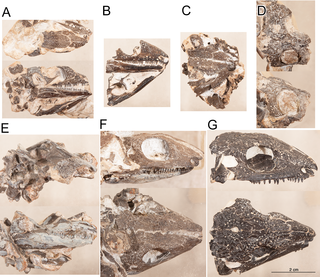
Delorhynchus is an extinct genus of lanthanosuchoid parareptile known from the late Early Permian Garber Formation of Comanche County, Oklahoma, south-central United States. It contains the type species D. priscus as well as a better preserved second species D. cifellii.

Aulacephalodon is an extinct genus of medium-sized dicynodonts, or non-mammalian synapsids, that lived during Permian period, about 299-252 million years ago. Individuals of Aulacephalodon are commonly found in the Lower Beaufort Group of the Karoo Supergroup of South Africa and Zambia. Rising to dominance during the Late Permian, Aulacephalodon were the dominant terrestrial vertebrate herbivores until they became extinct during the Triassic. No living relatives of Aulacephalodon exist today. Two species have been named, the type species, A. bainii, and a second species, A. peavoti. However, debate exists among paleontologists if A. peavoti is a true member of the genus Aulacephalodon. Therefore, a majority of the information known about Aulacephalodon is in reference to discoveries about A. bainii.
Nannaroter is an extinct genus of tuditanomorph microsaur within the family Ostodolepidae.
Plemmyradytes is an extinct genus of dissorophoid temnospondyl from the early Permian. It is an amphibamiform from the Eskridge Formation exposures of Nebraska. The type species is Plemmyradytes shintoni. The genus name derives from the Greek plemmyris and dytes ('diver'), while the species name honors John Shinton, a fossil preparator at the Denver Museum of Natural History where all known specimens of this taxon are reposited following collection in the late 20th century.
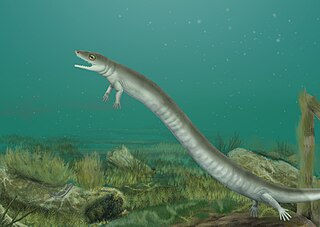
Recumbirostra is a clade of lepospondyl amphibians from the Carboniferous and Permian that includes the families Pantylidae, Gymnarthridae, Ostodolepidae, Goniorhynchidae, Brachystelechidae, and Microbrachidae. Recumbirostra was erected as a clade in 2007. It includes many lepospondyls traditionally grouped in "Microsauria", which has since been shown to be a paraphyletic grouping. Not all phylogenetic analyses recognize Recumbirostra as a valid grouping. An alternative clade called Tuditanomorpha is occasionally supported and includes many of the same taxa. Below is a cladogram showing the phylogenetic relationships of recumbirostrans from Glienke (2012):
Huskerpeton is an extinct genus of recumbirostran microsaur amphibian from the Early Permian Eskridge Formation of Nebraska, United States. It contains a single species, Huskerpeton englehorni. The genus was named for the University of Nebraska Cornhuskers.

Gordodon is an extinct genus of non-mammalian synapsid that lived during the Early Permian of what is now Otero County, New Mexico. It was a member of the herbivorous sail-backed family Edaphosauridae and contains only a single species, the type species G. kraineri. Gordodon is unusual among early synapsids for its teeth, which were arranged similarly to those of modern mammals and unlike the simple, uniform lizard-like teeth of other early herbivorous synapsids. Gordodon had large incisor-like teeth at the front, followed by a prominent gap between them and a short row of peg-like teeth at the back. Gordodon was also relatively long-necked for an early synapsid, with elongated and gracile vertebrae in its neck and back. Like other edaphosaurids, Gordodon had a tall sail on its back made from the bony neural spines of its vertebrae. The spines also had bony knobs on them, a common trait of edaphosaurids, but the knobs of Gordodon are also unique for being more slender, thorn-like and randomly arranged along the spines.












